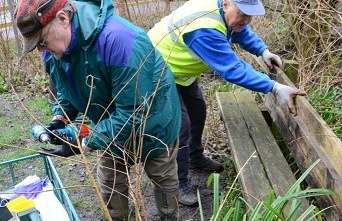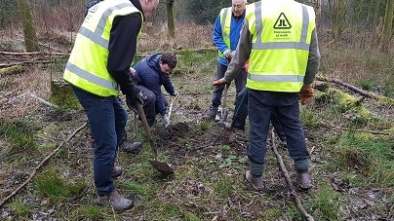Local volunteers felling trees and encouraging butterflies, birds and bats in Uppermill
Reporter : Judith Grinter
Viaduct Woodland – Uppermill Community Action Network (UCAN) and Street Scene Greenfield Group (SSGG), joint project day
UCAN and SSGG held a very successful and enjoyable joint project day working on the viaduct woodland.
There was a great turnout and a fantastic amount of progress was made. The group is extremely grateful for the help and support of Kate Hanley, from the RSPB who provided tree felling skills and a wealth of knowledge and advice, also the ongoing support of Phil Smith from Canal & River Trust and volunteers from Tesco, who kindly provided refreshments on the day.
Plans for the Woodland
The first stage was to fell enough trees in order to create an open ride through the middle of the area. This means that the extra light getting to the woodland floor will enable the team to plant lots of native woodland wildflowers, which will be great for butterflies and bees (after removal of the invasive non-native  Himalayan Balsam). Bats will also use the ride edges for hunting.
Himalayan Balsam). Bats will also use the ride edges for hunting.
The extra light will allow for the planting of native trees in amongst the remaining trees, like oak, birch, hazel, holly, hawthorn and wild rose, which will support a greater variety of wildlife than the trees which are there currently. Other plants will include climbers like honeysuckle and ivy, which are brilliant for wildlife – honeysuckle supports moths (which bats will eat), and ivy provides late nectar for insects and early berries for birds. Once it has matured, it is also used by nesting birds and summer roosting bats.
The felled timber has been left on site, as dead wood is a very important component of a healthy native woodland. It supports many insect species, which in turn support native mammals and birds. The piles of brash will provide nesting sites for birds like wrens, robins, dunnocks and blackbirds.
One of the larger trees has been ring barked, this will die standing up, so providing nesting opportunities for a range of birds, including the greater spotted woodpecker and the nuthatch.
The volunteers will be working on removing the Himalayan Balsam this spring and summer, and then planting the oaks, birches and other native trees next winter. If the Balsam has been controlled by next early spring wildflower seeds will be sown.
Please check their website for more details about the meets and how you can be involved – UCAN website




